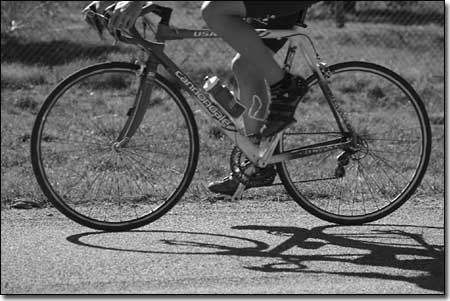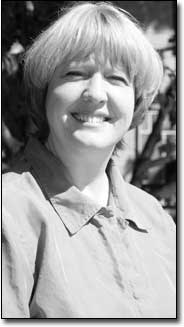 |
A
cyclist pedals through the valley near the Animas
River bridge on Trimble Lane earlier this week.
This Sunday morning,
20 riders from the Tour of Hope, a cross-country
road ride to raise awareness for cancer reasearch,
will stop in
Durango./Photo by Todd Newcomer
|
The first time her doctors diagnosed her with cancer,
Carol Smith didn't believe it. It wasn't a reaction of
shock, but rather genuine doubt. It turns out, she was
right. The second time, she wasn't.
Less than a year ago, 46-year-old Smith learned she
had chronic myeloid leukemia, a rare form of bone marrow
cancer. She immediately faced the likelihood of having
a bone marrow transplant, which historically has been
the medical course for patients in the chronic stage.
The transplant is risky, having a 50 percent mortality
rate and a reputation for taking an extremely unhealthy
toll on the body's organs – ones that are otherwise healthy.
She also would have undergone countless chemotherapy
treatments, a treatment so harsh that it kills everything
in its path regardless of disease status. So, Smith's
future was daunting.
It's at this point in Smith's story where she trumpets
the actions of people who financially support cancer
drug research and talks excitingly about the significance
of a group of cyclists that will arrive in Durango on
Sunday on a cross-country bike tour to raise this kind
of awareness.
After pedaling all night from the Grand Canyon, a 20-member
team will arrive at Morehart Subaru on Sunday morning
to rally as part of the Tour of Hope. The tour is a weeklong
3,500-mile ride from Los Angeles to Washington, D.C.,
put on by drug manufacturer Bristol-Myers Squibb, with
the help of cycling great Lance Armstrong.
 |
Local cancer survivor Carol Smith
stands outside her Durango office on
Tuesday. Less than a year ago, Smith,
46, learned she had a rare form of
leukemia. But thanks to the results of
a clinical drug trial two years ago, she
was able to take a new medication
instead of going through a risky bone
marrow transplant. Her cancer
appears to be heading into remission./
Photo by Todd Newcomer |
Armstrong, who won his sixth Tour de France this year,
survived cancer – in part because of the drugs made by
Bristol-Myers Squibb. It started out as testicular cancer,
but soon aggressively spread to Armstrong's brain and
lungs. Since going into remission and returning to professional
cycling, Armstrong has become an active and outspoken
advocate and fund raiser for cancer research. Much of
that research is done during clinical drug trials, when
medical professionals test new and more effective cancer
antidotes.
Part of Armstrong's work off the bike includes participating
in the annual Tour of Hope, which draws on cancer survivors
from all parts of the country to hop on their bikes and
spin thousands of miles to share their stories of survivorship.
If cyclists aren't cancer survivors, they are physicians,
nurses, researchers or caregivers. The stories are personal,
painful and promising.
Smith, a technical support specialist for the City of
Durango, is enthusiastic about such endeavors because
the results of a clinical drug trial two years ago lead
to a new medication on the market for the treatment of
the type of leukemia that afflicts her. (Her previous
cancer scare turned out to be a benign kidney tumor.)
“For me, it was actually and truly a lifesaver,” Smith
says.
She was able to forego an unpleasant bone marrow transplant
and instead take a pill that acts as a form of chemotherapy.
Instead of enduring months of intravenous dosing that
would kill even healthy cells, Smith takes 1BD pills
per day that doctors know are killing only her unhealthy
cells, nothing else.
The drug is expensive – nearly $4,000 per month – but
Smith calls it a “huge breakthrough.” When her doctors
tested Smith's initial blood cells, 72 percent of her
white blood cells were abnormal. Today, only 4 percent
are abnormal.
“This is the hopeful thing about a drug like this,” Smith
says. “Doctors are starting to get 4 away from types
of chemo that kill everything, allowing people to lead
more normal lives while being treated.”
Katie Walsh opted for a similar treatment to beat her
cancer. Walsh, a 45-year-old substitute teacher, yoga
instructor and fund-raiser, has been free of cancer for
1BD years. In May 2003, her doctors found cancer in her
breast. For the exceedingly active Walsh, it was a tremendous
blow.
“I made my doctor go back to the hospital and check
the results to make sure they were actually mine,” Walsh
says.
Unfortunately, they were.
A normally optimistic Walsh was crushed. Immediately,
she began shopping for wigs, prematurely assuming she'd
undergo months of chemotherapy that would cause her hair
to fall out. She had experience with this, after all.
Walsh's father had colon cancer, which eventually spread
to his lymph nodes. He underwent aggressive treatment
and actually beat it, having remained in remission for
10 years before he passed away last summer. Seeing her
father so ill prompted Walsh to slow down and consider
her alternatives.
After undergoing a lumpectomy, Walsh opted to continue
the treatment with radiation and a pill form of chemotherapy
that targeted only her cancer cells. It worked.
She also examined her attitude toward the disease.
“I took it as an opportunity to grow through instead
of go through,” she says. “Attitude is key for survivorship.
I think it's important for people to take responsibility
for what they can, not sit back and be a victim of the
disease.”
Ultimately, her approach to dealing with cancer changed
her outlook on her competitive spirit. An avid cyclist,
Walsh stopped racing her bike and started “riding” it.
She realized that the competition aspect was causing
her to simply endure an event instead of enjoy it.
It also compelled her to become a cancer research advocate
by using her bike. After finishing a daily two-month
regimen of radiation in March, Walsh began her involvement
with the Lance Armstrong Foundation, the cyclist's nonprofit
advocacy group. The Foundation's Peloton Project has
members raise funds for cancer research, providing incentives
along the way.
As a member, Walsh hosted a 4
Durango screening of a behind-the-scenes documentary
of the Tour de France this Spring. She raised $5,000.
For that, Walsh will participate at the Foundation's
annual Ride for the Roses event in Austin, Texas, next
week. The event, reserved for fund-raisers meeting a
specific goal, she'll mingle with other cancer survivors
and supporters.
Walsh is also helping put on the Durango rally for the
Tour of Hope this weekend – an event she says will allow
her to support others who may have gone through similar
ordeals as hers.
“I'll be able to connect with them on an emotional level,
because we all have that same sense of shock we went
through in finding out about our cancer,” Walsh explains.
She will also relish in being among others who, like
her, made a conscious choice to survive the disease and
learn about personal strength.
“Most cancer survivors say they wouldn't change it and
not have gone through it,” Walsh says, including herself.
She and Smith attribute this, of course, to support
from friends and family. Smith says her endurance comes
also from her faith in God. But she never discounts the
necessity for cancer research to continue so that, she
says, others can have as much success in healing as she
has.
“I want people to understand that their contributions
to cancer research are going somewhere. They are doing
things with that money.”
She cites her own story as proof. Her prognosis, she
says, is “extremely good” and her doctor is “thrilled” with
the speed and extent of her progress. Though Smith doesn't
know how she became sick with her type of chronic leukemia,
which medical professionals claim is caused by environmental
toxins, she doesn't go back to try to figure it out.
“I have every reason to hope that soon there won't be
any sign of it, hopefully as early as in a couple of
months.”
|